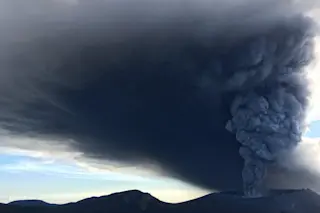Kirishima in Japan erupting on October 12, 2017. Image by James Reynolds, used by permission. For the first time since September 2011, Kirishima in Japan has started erupting. On the morning of October 11, new ash emissions began from the Shinmoe-dake cone on the large, complex volcano on the north end of Kagoshima Bay. The eruption have been relatively small ash-and-gas plumes that reached less than 1 kilometer (~3,200 feet) over the volcano and spread shards of volcanic glass (aka ash) across the area. These new explosions have promoted the Japanese Meteorological Agency (JMA) to raise the alert status to Level 3 and declare an exclusion zone around the active vent. The plume from the eruption was clearly seen on Terra MODIS image (below) taken on October 11 (Universal time, so October 12 local).
The grey plume of ash spreading east (right) from the eruption of Kirishima, seen clearly against ...














